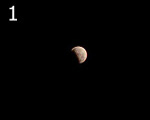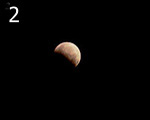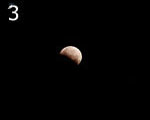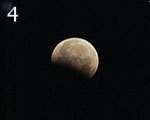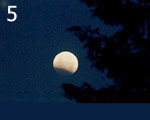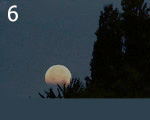Click on any of the images for a larger
view
Eric's Report
On the morning of July 28th there was a partial lunar eclipse
visible to those in Western Canada and the United States. From
here in Victoria we were able to see nearly the entire event before
dawn and the western horizon intervened.The Moon moved into the
earth's umbral shadow at 0322 and by 0434 it had reached the maximum
coverage. It exited by 0545.
I woke up at about 0325 PDT and was able to start photographing
at 0353. I started with a 135 mm lens using Fuji Superia 400 and
bracketed the exposure settings. The example here, #1 is 1/60th
second at F5.6.
The next is with a 200mm lens at 1/60th second at F5.6. It
is at 0429 PDT and shows the image size difference between the
two lenses. It's also noticable that the Moon is more deeply immersed
in the umbral shadow.
Number three is at the same settings as #2 and is included
as it was at 0442 PDT, a few minutes before maximum coverage.
In #4 a 600mm lens was used at F11 with a 1/125th second exposure.It
was taken at 0502 PDT and you can contrast and compare image size
with the others.
By 0513 I had moved to a different location in front of the
house, graduating from being a backyard astronomer. It is just
beginning to show some signs of dawn and the tree gives a nice
context for the Moon. Both of the last images are with the 600mm
telephoto at F11, #5 is a 1/15th second exposure and #6 is 1/125th
second.
This project was really fun and satisfying. It was still possible
to get another hour or so of sleep and then have the film developed
later on the same day. These images were then scaned by an HP
PhotoSmart negative scanner and processed in Adobe Photoshop.
There's something about transitory phenomena such as an occultation
or eclipse that makes photographing them not only a bit challenging
but also exciting. It's a live performance that is only given
now and then and the replay may not come again for a long time.
Eric can be reached by email at eric_schandall@telus.net

David's Report
Despite a dead camera battery, I still got a shot of the partial
lunar eclipse on Wednesday morning July 28th. It was as a beautifully
clear morning. I started watching the shadow creep over the surface
of the moon at about 2:45am PDT. The shot I included is from I
think 4:10am PDT, 20 minutes or so before the maximum coverage.
As with most of my lunar shots the image was taken with a Televue
Pronto and a Tamron 2x Teleconvertor at the camera body. The film
was Fuji Superia 400, exposure 1/60 sec effective aperture f/14.
Negative scanning was done with a Polaroid Sprintscan and processed
in Adobe Photoshop 5.02.
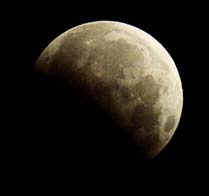 David can be reached by email at David_Lee@telus.net
David can be reached by email at David_Lee@telus.net
As a side note Richard Harvey, Jean Godin and I were at
the Pearson College Observatory Friday night July 30th /Saturday
morning July 31st hoping to get a glimpse of a dust plume from
Lunar Prospector. Alas no dust plume, the first reports in the
morning on the news indicated they weren't even sure it landed,
later on in the day it was confirmed. - David Lee
| 
